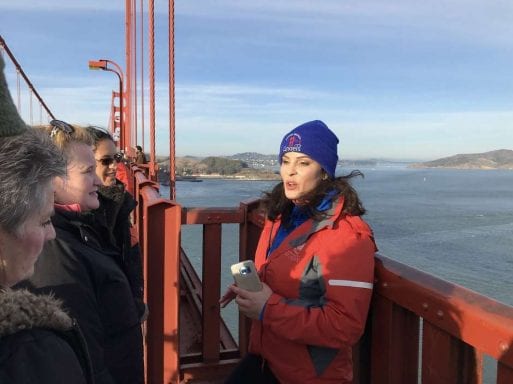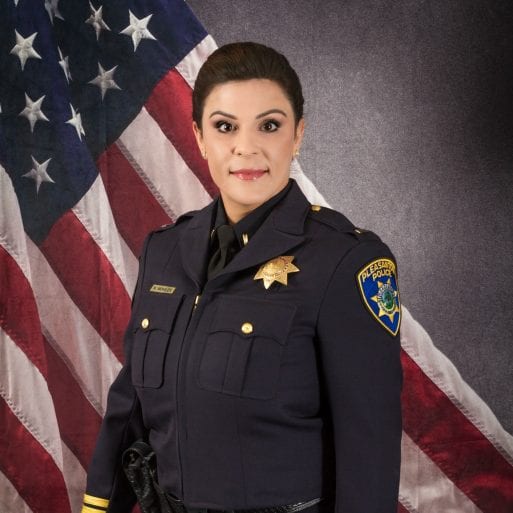
Mia Munayer
Credit: sfchronicle.com
Mia Munayer is the fiercely intelligent, compassionate, self-possessed founder of Bridgewatch Angels, a group that works to prevent suicides on the Golden Gate Bridge, and a police lieutenant in Pleasanton, California, a suburb of the Bay Area. Munayer was made aware of the prevalence of suicides on the Golden Gate Bridge in San Francisco when she attended a Crisis Intervention Training for work. During the training, facilitators screened “The Bridge,” a 2006 documentary about suicides on the Golden Gate Bridge in San Francisco. Munayer tells me, “Before seeing the film, I had no idea that the Golden Gate Bridge was the number two suicide destination in the world and that every day, approximately two to three men, women and children come to the bridge to end their lives.” Munayer was particularly impacted by the testimony from bridge jump survivor Kevin Hines, who shared the moment of regret he experienced as soon as his hands left the rail. “He jumped because he felt alone at the moment and believed no one cared,” Munayer says. “At that moment, I felt compelled to take action and mobilize others to join me in a ‘boots on the ground’ approach to saving lives on the Golden Gate Bridge.” That “boots on the ground” approach would take shape in the form of an organization called Bridgewatch Angels, a collective of volunteers who come together on all major holidays to help prevent suicides on on the Golden Gate Bridge. After receiving formalized training at one of the holiday Bridgewatch events, volunteers can also go to the bridge for suicide prevention work throughout the year.
More than just a calling, Bridgewatch Angels has become a family affair Munayer. Her husband, a police sergeant, volunteers with the suicide prevention group, as does her 19-year-old eldest son. When her other four children turn 18, the minimum age requirement for becoming a volunteer, they will be invited to join their parents and brother on the bridge.
Bridgewatch Angels has a permit that allows 100 volunteers to participate during each event. “Generally, our volunteer waiting list is several hundred,” Munayer says. When volunteers arrive at the bridge on holidays, they first go through a 45-minute orientation discussing the warning signs of someone in distress, how to approach and interact with a suicidal person, and safety protocol that includes how to interface with the Bridge District Police in emergency situations. Before patrolling the bridge, each volunteer is assigned a partner. One is the designated “contact person” and the other is the “observer.”
It is the contact person’s job to approach individuals on the bridge. The contact person starts with a light, friendly greeting and gauges the response. The contact person is watching for signs of distress that include a slow/incoherent speech pattern, increased hand gestures, touching or scratching the face, covering mouth/face, perspiration, fidgeting, agitation, crying, or resting body against the railing. If the contact person believes the individual might pose a threat to themselves, they signal their observer, who then calls the Bridge Police. The contact person continues to engage the individual in conversation while the “observer” flags down police when they arrive.

Mia Munayer
Ellary Allis: How was Bridgewatch Angels founded?
Mia Munayer: Prior to forming the organization, I conducted extensive research to fully understand the prevalence of suicides at the Golden Gate Bridge, but more importantly, to listen to the stories from family survivors who lost loved ones at the bridge. I also familiarized myself with the research of UC Berkeley professor and clinical psychologist Richard Seidan, who dispelled the myth that people who were prevented from taking their lives at the Golden Gate Bridge found other means to die by suicide thereafter. The answer is that they don’t, and the research is compelling.
I partnered with the Bridgerail Foundation and other suicide prevention organizations to share my mission and strategic plan, which included social media outreach. I realized the need for volunteers was immediate and of critical importance to saving lives while the suicide barrier was not yet approved.
Ellary: Your organization is well known, and very respected. As you said, you always have more people wishing to volunteer than you can accommodate. How were you able to spread the word about Bridgewatch Angels, initially?
Mia: I received tremendous support from mainstream media outlets whose reporters not only covered the Bridgewatch events, but even participated in Bridgewatch themselves and posted about it on their social media pages. That brought members of the Bay Area community to our social media pages. Our mission resonates with a lot of people, so our volunteer waiting list has grown and grown over the years.
Ellary: Does the work on the bridge ever become emotionally overwhelming for volunteers? And if so, how do you handle that?
Mia: Every event we have is dedicated to the memory of a person who jumped from the Golden Gate Bridge. The person’s family joins the Bridgewatch Angels to honor the memory of their loved ones. Family survivors of bridge suicides who volunteer sometimes have a very difficult time. Some of them become overwhelmed with emotion and need to leave. So we tell family members that they if they want to join us, great. If it’s too much for them, they, of course, are not obligated. It’s completely acceptable to leave if they need to. I also think the presence of family survivors is very impactful and important for our other volunteers. To hear the family member of someone who jumped say, “I don’t think he/she would have jumped if there had been someone there to intervene” really hammers home to the other volunteers how critical this suicide prevention work is.
Ellary: I know there is ongoing construction on a suicide deterrent net. Can you explain what that is? And will there still be a need for Bridgewatch Angels when it’s completed?
Mia: Yes, the barrier is stainless steel mesh net approximately 20 feet below the nearly 2.1-mile-long span of the bridge. It’s set to be completed in January 2021, and it’s a testament to the will of the community to solve the issue. Suicide barriers like this are effective deterrents, and do decrease the number of deaths in places where they are installed. In some suicide hotspots where barriers like this are installed, the suicide rate has gone down to zero.
But Bridgewatch Angels will continue its mission, regardless. Apart from our suicide prevention work, we also engage in other humanitarian efforts. We’ve done outreach for fire victims, driving up to Petaluma to drop off requested supplies to the shelters housing evacuees. During the partial government shutdown in January, we collected diapers, baby formula, dog/cat food, children’s non-perishable snacks, and feminine hygiene products for Coast Guard members when they weren’t receiving paychecks and were struggling to afford these necessities. Coast Guard members at Station Golden Gate have recovered thousands of jumpers from the bridge and have saved many lives, so we wanted to support them.
Ellary: Do people ever succeed in jumping even while Bridgewatch Angels are walking the span of the bridge?
Mia: On holidays there are only 100 of us, and the bridge spans 2.1 miles, so occasionally yes, that does happen, and it’s devastating. It doesn’t happen very often, but it does happen. We do our best with our suicide prevention work and we have, thankfully, generally been able to intervene when we’re on the bridge.
Ellary: Have you had any particularly impactful encounters on the bridge that have stood out to you?
Mia: My most impactful encounters occur when Bridgewatch Angels volunteers approach me at the end of an event to share their story of attempting suicide at the Golden Gate Bridge — how they were stopped by one of our volunteers and never forgot how the intervention gave them a second chance at life. They come to the event to “pay it forward.” They understand the power of human connection and empathy. They understand the importance of suicide prevention work. Most importantly, they believe as I do, that anyone can save a life and ease the suffering of others.
Ellary: Thank you so much, Mia, for the work you do and for taking time to speak with Sevenponds!
Mia: It was my pleasure!

 Volunteering to Prevent Suicides on the Golden Gate Bridge
Volunteering to Prevent Suicides on the Golden Gate Bridge


 How Dare You Die Now!
How Dare You Die Now!
 Debating Medical Aid in Dying
Debating Medical Aid in Dying
 “Help Me, Helen”
“Help Me, Helen”














